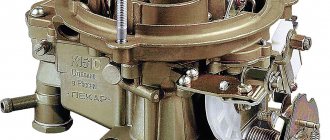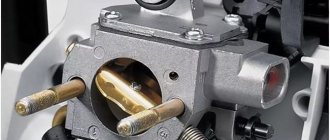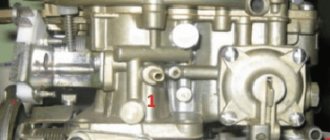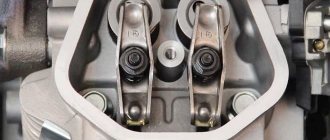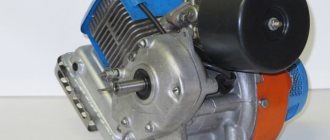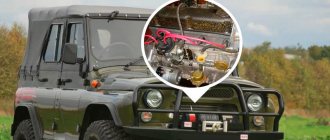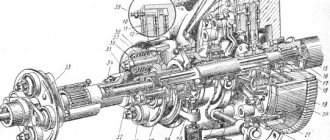I bought a rem a long time ago. kit for the K-151-V carburetor, I couldn’t even begin to sort through everything. Lately the engine has started to run poorly, symptoms: Starts well when cold. It starts very hard when hot. It pulls well only at high speeds. At low levels the traction is weak.
Possible reasons: overflow, needle does not hold. dirty jets, old gaskets, leaking air, gasoline.
In rem. The kit is missing some minor gaskets and XX jets. The bolt with the needle did not fit, it fits the K-151-D model, the thread is smaller, but the needle went into the old bolt, I bought the bolt from GAZ... I don’t remember the model, I selected it according to the thread.
I modified the passage bolt a little, drilled holes in a circle so that the stream would not hit the top. I straightened all the bends to ensure a tight fit of the gaskets.
After assembly and installation on the car, it started up with half a turn, the speed is excellent. I warmed it up, turned it off, started up just as well, I haven’t left the garage and it’s raining, I think everything is fine. The result is rem. the kit helped, straightening the bends, set everything up as it should have been initially and everything works.
1-cover; 2-valve for unbalancing the float chamber (only on K-151V carburetors); 3-float; 4-air jet of the secondary chamber transition system: 5-fuel jet of the secondary chamber transition system; 6-threaded screw holder for econostat sprayer; 7-main air jet of the secondary chamber; 8-econostat sprayer; 9-emulsion tube of the main dosing system of the secondary chamber; 10-accelerator pump nozzle holder with discharge valve; 11-accelerator pump nozzle; 12-air damper; 13-insert small diffuser of the secondary chamber with atomizer; 14-main air jet of the primary chamber; 15-emulsion tube of the main dosing system of the primary chamber; 16-block fuel and air idle jets with emulsion tube; 17-emulsion jet of the idle system; 18-second idle air jet; 19-adjusting needle on the accelerator pump drainage channel jet; 20-travel limiter for the suction ball valve of the accelerator pump; 21-carburetor body; 22-bypass (drainage) jet of the accelerator pump; 23-ball suction valve of the accelerator pump; 24-accelerator pump diaphragm suction stroke spring; 25-accelerator pump diaphragm; 26-accelerator pump diaphragm cover; 27-accelerator pump drive lever; 28-main fuel jet of the primary chamber; 29-connection of the EPHH valve; 30-diaphragm valve EPH; 31-shut-off valve EPHH; 32-plug plastic screw stop
1 – screw-plug of the float axis; 2 – tide for installing the electromagnet of the float chamber ventilation system (in K-151V carburetors); 3 – threaded plug of the fuel nozzle of the secondary chamber transition system; 4 – vacuum tap into the vacuum regulator of the ignition distributor; 5 – vacuum sampling fitting to the EPHH control valve; 6 – fitting for the crankcase ventilation system; 7 – boss with fuel fittings; 8 – boss fastening screw;
9 – vacuum control fitting for the exhaust gas recirculation valve; 10 – threaded plug of the emulsion jet of the idle system; 11 – boss for the float chamber ventilation fitting (only for K-151V); 12 – threaded plug for draining fuel from the float chamber; 13 – fitting for supplying vacuum to the EPHH valve; 14 – screw for adjusting the mixture composition at idle (the “quality” screw); 15 – screw-stop of the primary chamber damper lever; 16 – EPHH control microswitch; 17 – idle speed adjustment screw (quantity screw);
18 – coupling screw of the halves of the double-arm starting lever; 19 – starting device control lever; 20 – lever on the air damper axis; 21 – air damper drive rod; 22 – microswitch of the EPHH system; 23 – freewheel tension spring of the throttle valve control lever; 24 – overhead lever of the starter control cam; 25 – adjusting screw for the position of the air damper drive rod; 26 – opening antenna of the throttle valve lever of the secondary chamber; 27 – closing antenna of the throttle valve of the secondary chamber; 28 – cam of the starting device; 29 – screw-stop of the secondary chamber damper lever;
30 – fuel outlet fitting; 31 – screw for fastening the accelerator pump cam (option); 32 – fuel supply fitting.
The production of the K-151 carburetor is carried out at the PeKAR enterprise. It is used in power units of UZAM and ZMZ. In order to achieve the highest quality functioning of this part, it is necessary to adjust the K-151 carburetor from time to time.
Adjusting the idle system
To perform work, you must monitor the tachometer readings. We warm up the engine and set the quality screw to such a position as to achieve the maximum idle speed. Then we set the frequency higher by 100-200 rpm, using the quantity screw for this. After this, we tighten the quality screw until the optimal rotation speed is reached (it should decrease by about 100-200 rpm).
When adjusting the K-151 carburetor, care must be taken to avoid too much depletion of the mixture using the quality screw, since otherwise the engine will operate unstably and will stall at idle. If, while tightening the mixture quality screw, the speed decreases, this is a sign that the K-151 carburetor has been adjusted correctly. But if the speed does not decrease, this may indicate the need to repair the K-151 carburetor due to the failure of its components.
It should be noted that this method of tuning the carburetor allows you to achieve optimal values for the level of harmful emissions. According to GOST, the level of CO and CH in exhaust gases should be no more than:
- CH – 1200 ppm, CO – 1.5% (550-650 rpm);
- CH – 600 ppm, CO – 2% (2650-2750 rpm).
In order to configure the K-151 according to all the rules, it is recommended to use a gas analyzer.
Solex 21073
At one time it was fashionable to install the DAAZ Solex 21073 carburetor on the Gazelle. The carburetor was sold in car shops even with an adapter included for a GAZ air filter; it was originally intended for installation on a Volga with a ZMZ 402 engine. But this fashion, however, passed quickly enough. Designed to save fuel, the Solex quickly became clogged.
Instead of saving money, it consumed even more fuel than the K151D, and the car did not want to drive normally. A typical problem in the “carba” model 21073 was the clogging of the idle jet on the solenoid valve, and when it was dirty, the engine generally refused to idle - it constantly stalled and did not develop power.
Adjusting the fuel level in the float chamber of the K-151 carburetor
Unscrew the screws that secure the cover, lift it slightly and pull out the gasket. After this, you need to move the cover to the sides as far as possible. In this case, it is not necessary to disconnect the trigger mechanism.
At the next stage, you need to pump fuel into the float chamber, for which you use the appropriate lever. It is necessary to pump until the gasoline level stabilizes. The distance to the top plane of the carburetor body should be 21.5 millimeters.
If the level is too low, you need to bend the float tongue up. If the level is too high, you need to bend the tongue down. After changing the position of the tongue while adjusting the K-151 carburetor, it is very important to always drain the fuel from the float chamber using the drain plug.
K151D
The Gazelle with the 406 engine had its own carburetor, and it was somewhat different from the Volgovsky, which came with the 402 engine. The markings on the carburetors were also different: the Volga had the K151S model, and the Gazelle had the K151D. Externally, the devices are exactly the same, the only difference is in the filling. In the K151D model, the nozzles of the accelerator pump inject fuel into both chambers of the carburetor at once; on the K151C, only into the first chamber. Carburetors also have different jet sections.
The carburetor ZMZ 406 on the Gazelle has one problem - the Gazelle’s rather high fuel consumption, especially when the car is loaded and travels at speeds above 60 km/h. The problem is still present, and every owner of a commercial vehicle is trying to solve it in his own way.
Adjusting the carburetor starting system
The adjustment must be performed on a preheated power unit with a tachometer. The air filter must also be removed.
To configure the K-151, you need to start the engine and lightly press the gas pedal. At this moment, the air damper must be closed using the drive handle. Then you need to open it slightly using a screwdriver, and the crankshaft should rotate at a frequency of about 2.5-2.7 thousand revolutions per minute.
If the crankshaft rotates at a different speed, it is necessary to loosen the locknut on the adjustment screw and tighten or unscrew it. These actions should be performed until the optimum crankshaft speed is achieved.
At this point, the procedure for setting up the K-151 carburetor can be considered complete. We also recommend watching a video about adjusting and repairing the K-151 carburetor:
Fuel consumption directly depends on the condition of the fuel system, and if there are faults in it, the car's dynamics also deteriorate and the engine begins to operate unstably.
This article will discuss the K151 carburetor: design, repair, adjustment, configuration features, as well as the main problems and their symptoms.
Replacing a carburetor with an injector on a ZMZ-4063 engine
In order to improve technical characteristics, quite often Gazelle owners replace the carburetor system with an injector, although this pleasure is not cheap. For such a modification it will be necessary to purchase additionally:
- air flow sensor;
- electric fuel pump;
- other wiring for the engine;
- intake manifold (receiver) assembled with dampers;
- air pipes;
- DTOV (ambient temperature) and TPS (throttle position) sensors;
- fuel rail with injectors and fuel pressure regulator;
- the engine control unit;
- front small engine cover;
- both camshafts (differ in cam profile);
- fuel filter;
- air filter housing (“can”) assembled with a filter element;
- idle speed controller.
You may also need various small things, such as gasoline hoses, clamps, fuses, gaskets, fuel filter bracket, etc. The work here is labor-intensive, but the end justifies the means. The advantages of an injector over a carburetor are significant:
- the engine receives a significant increase in power;
- no need to constantly struggle with adjusting and cleaning the carburetor;
- You can install HBO of almost any generation, except the first.
Some injector spare parts are expensive, but it is not necessary to purchase them at the store. Excellent quality used parts can be found at car dismantling yards or through advertisements from private traders, especially since you can almost always bargain. Definitely, it is better to buy a used collector (receiver), since it almost never wears out, and there is no point in overpaying here.
Video on repairing the Gazelle ZMZ 406 engine:
When experienced motorists casually throw out the phrase “before, technology was extremely reliable,” they are, in a certain sense, right. Indeed, is it worth comparing the level of complexity of a modern car and its analogue from 50-60 years ago? And if the product is simple, then by definition it is more reliable. Owners of cars of the latest generations will certainly agree with this: if major breakdowns at the initial stage of operation are very rare, then you only need to have time to deal with minor faults.
In this aspect, the products of the Leningrad Carburetor Plant can be considered legendary, and its flagship is rightfully recognized as the K-151 carburetor, better known under the pseudonym Pekar. Its reliability is legendary; it is no coincidence that it is used on vehicles with ZMZ and UZAM power units, in particular on the famous domestic UAZ SUV. But, as you know, this device demonstrates the greatest efficiency with the correct settings. Today we will tell you how to achieve this.
K-151 carburetor design
In the fuel system, the carburetor of the K-151 model performs the function of preparing the air-fuel mixture in the composition necessary for the operation of a car engine under various loads - at idle, at medium or maximum speed. This unit is used on Volga and IZh passenger cars, Gazelle and Sobol commercial vehicles, and UAZ SUVs. There are various modifications of the “one hundred and fifty-first”, and depending on its model, a letter is added to the name at the end, for example, the GAZ-3102/31029, GAZ-3302 “Gazelle” cars are equipped with the K-151S carburetor. Also, depending on the K-151 model, jets can be installed with different sections - much depends on the characteristics and size of the engine.
The 151 series carburetor consists of the following systems and elements:
- main body (middle part) with a float chamber;
- throttle body – the valves rotate due to the drive connected to the accelerator (gas) pedal;
- the top cover of the float chamber - it contains a locking mechanism that prevents the chamber from overfilling with gasoline, as well as an air damper necessary for starting a cold engine and warming it up;
- main dosing system - is the main one in the preparation of the air-fuel mixture (FA), consists of channels of a certain cross-section, two fuel and two air jets;
- idle system, which is necessary for stable operation of the internal combustion engine at idle speed - it includes a bypass channel, adjusting screws (quality and quantity of fuel assemblies), jets (fuel and air), an economizer valve with a membrane mechanism;
- accelerator pump - it allows the car to drive without failures during sudden acceleration, consists of additional channels in the main body, a ball valve, a diaphragm mechanism and a fuel sprayer;
- econostat - the system is designed to enrich fuel assemblies at high engine speeds; it represents additional channels through which, under the influence of high vacuum when the throttle valves are open, an additional portion of fuel enters the intake manifold;
- transition system - it is needed for a smooth increase in speed at the moment the throttle valve begins to open in the secondary chamber; it consists of fuel and air jets.
The K-151 carburetor consists of two chambers, the throttle valves in it open sequentially, and a filter - a protective mesh - is installed at the inlet of the fitting. The unit is also equipped with a return fuel line, through which excess gasoline is discharged back into the gas tank, and the “return” does not allow the creation of excess fuel pressure. The design of the K-151 carburetor itself is quite complex, and in order to repair and adjust the unit, you need experience and strict adherence to the repair instructions.
Several hoses of two diameters are connected to the K-151 carburetor - if they are mixed up, the engine will not work properly. We connect the hoses in the following order:
Removing the carburetor on a car with a ZMZ-4063 engine
Removing and installing the factory CU on the 406th engine is quite simple; all operations are performed in the following order:
- with the engine off, remove the air filter housing: first the crankcase gas hose, then the upper part (five latches), the lower “can” (three nuts or bolts for 10);
- disconnect all hoses, including fuel, as well as choke and gas cables;
- unscrew the four nuts securing the assembly itself;
- The KU body may stick to the seat, in this case you need to try to loosen it from side to side, you can carefully pry it from below with a pry bar; knocking is not recommended.
Installation is carried out in the reverse order of removal, as you can see, everything here is very simple.
Adjustment
If without experience it is quite difficult for car owners to repair the K-151 unit with their own hands, then it is easier to master the adjustment, the main thing is to understand the principle of operation of the device and act according to the instructions. There are several types of “one hundred and fifty-first” adjustments:
- idle move;
- air damper position;
- gasoline level in the float chamber;
- throttle position.
Changing the fuel level in the float chamber should be trusted to experienced carburetor specialists, but any driver can adjust the idle speed independently. We carry out the procedure as follows:
If the engine speed is high, you should reduce it using the screw that adjusts the position of the throttle valves. This screw often boils tightly, and it is impossible to turn it in any direction (in the picture below, under the number 4, under the white paint).
There is one “tricky” way to force the adjusting element to turn - you need to install a flat-head screwdriver in its slot and carefully hit it several times with a hammer (you need to feel the force, otherwise you can break parts of the carburetor). The screw will “come away” and begin to rotate on the thread. If the “trick” does not work the first time, it should be repeated. It is important to take your time and be patient, then everything will work out.
Fuel consumption – according to factory standards and real
According to technical passport data, fuel consumption at a speed of 60 km/h with the ZMZ 4063 and ZMZ 4061 engines is 10.5 liters, at a speed of 80 km/h – 13 liters. But during control measurements many factors are not taken into account:
- Car load;
- Weather;
- Road conditions;
- Technical condition of the car.
These standards can be met if the car is operated in the summer on a dry road, without a load and in fully working order. Much still depends on driving style. The harder the driver presses the gas, the more fuel is consumed. Gasoline consumption also depends on its quality. It has been noticed that fuel with a higher octane number is consumed less. Therefore, for the Gazelle it is preferable to fill with AI-95 fuel instead of AI-92.
Comparison table for fuel consumption in various modifications of the Gazelle car
Repair
During the operation of the car, various malfunctions may occur in the carburetor; the main signs of malfunctions in this device are:
- increased fuel consumption;
- black smoke from the muffler pipe, it is especially noticeable if you press the gas pedal sharply;
- unstable operation at idle, the engine may also stall when the speed is reduced;
- poor car dynamics;
- failures when accelerating.
If the carburetor is faulty, the engine may not develop speed, and popping noises and shots from the muffler are often heard in the intake manifold. K-151 is a rather complex unit, and almost any element of it can fail.
There are reasons why a carburetor most often fails:
- jets, fuel and air channels become clogged;
- heating causes deformation of the body;
- the float chamber shut-off valve stops working;
- Over time, the jets wear out.
Many repairmen, when restoring the functionality of the carburetor, first of all try to replace the jets, believing that because of them, fuel consumption increases and the engine runs unstable. One rather important note - the jets wear out very rarely, and most often wear occurs when the carburetor is often operated in dusty conditions. The most common reason for poor carburetor performance is its clogging, but in order to thoroughly clean the unit, it is necessary to completely disassemble it. Repair of the K-151 carburetor is carried out with the removal of the device, complete washing and purging of all its parts.
Often, car owners switch cars with carburetor engines to gas; for example, it is profitable to install LPG on a working Gazelle. But with the constant use of gas in the carburetor, various types of problems appear, and one of them is a malfunction of the cold start system on the carburetor.
On many cars, the gas system uses a gas spacer for the K-151 carburetor; it is placed between the main body and the throttle body. Due to the additional insert, the distance between the lower and upper parts of the carburetor increases, so the cold engine starting system begins to work irregularly - you have to constantly keep your foot on the gas pedal, while holding the choke. On gas, a choke that is not fully working does not affect the operation of the engine, but the whole point is that cold starts of the engine, and especially in winter, are carried out on gasoline. Therefore, it is quite problematic to start the internal combustion engine with the air damper not completely closing; even due to the resulting vibrations, the fastening of the damper axis is often unscrewed. How to get rid of such an unpleasant problem?
One of the options for solving the problem is to weld an additional strip onto the air damper rod, which allows you to compensate for the difference in the thickness of the standard gasket between the housings and the gas spacer.
The bar can be made from an electrode with a diameter of 2 mm.
If the parts are severely worn, the carburetor needs to be replaced; most often it is changed if the housing wears out:
- the lower surface of the middle part is severely deformed;
- the cover (upper part of the body) is warped;
- The seat for the throttle valves in the lower part wears out.
The price of a new K-151 carburetor is quite high (on average 5.5-6.5 thousand rubles), but it is impossible to drive with a faulty device, especially since with high fuel consumption even more money is lost. Changing the K-151 is quite simple; let’s look at the process of replacing it on a Gazelle car:
If malfunctions occur in the carburetor accelerator pump, the engine begins to “choke” and failure occurs when the engine speed increases sharply. Quite often, the reason for such operation of the internal combustion engine is a clogged “nose” of the fuel nozzle; the accelerator pump diaphragm can also fail.
Diaphragm defects are determined by its external inspection; it can be easily reached without removing the carburetor from the engine. To do this, you need to unscrew the four screws of the cover (number 11 in the picture below), but you need to remove it carefully - it is important not to lose the spring, which is located inside the unit.
To determine the serviceability of the accelerator pump atomizer, you need to remove the air filter housing, turn the throttle valve by hand and see if fuel flows through the “spout” of the accelerator. If the nozzle is clogged, you can try to blow it out, but this will require removing the carburetor cover. If the spout does not blow through, it should be replaced; the work of replacing it is also carried out without removing the entire assembly. We replace the accelerator pump nozzle as follows:
If the engine consumes a lot of fuel, one of the reasons for this phenomenon may be a faulty needle valve in the float chamber - it is not sealed, and too much gasoline enters the chamber. In some cases, the valve completely stops holding fuel, then the carburetor is completely filled with gasoline, and the car does not start. Changing the needle valve is very simple:
About the book
: Management.
Edition 2003. Book format
: pdf file in zip archive
Pages
: 76
Language
: Russian
Size
: 9.3 mb.
Download
: free, without restrictions and passwords
Connecting hoses
The complex structure of the K-151 is also evident when it is connected to the engine. It provides for the use of a whole range of hoses, but only two different sizes are used, so it is quite possible to confuse them, and the motor will malfunction in certain modes. The order of connecting the hoses to the carburetor:
- Fuel is supplied through the fuel pipe to a fitting located under the float chamber on the engine side;
- the return hose is put on the lower fitting - it looks in the direction opposite from the power unit and is located below the inlet;
- two small cross-section hoses are connected to the solenoid valve, the other end of one of them is connected to the economizer valve;
- the second end of the thin hose is put on the fitting located in the lower part of the K-151 on the back side of the DZ body (there are two of them standing next to each other, we use the lower one);
- onto the upper fitting of this pair we pull the hose that goes to the vacuum ignition advancer (it is located on the distributor);
- a large diameter fitting on the DZ housing is used to connect the forced crankcase ventilation pipe, a device usually located on the valve cover;
- a small diameter fitting located in the middle part of the K-151 is used to connect a thermal vacuum switch, however, this pipe is used only if the engine has an exhaust gas recirculation system. If such a system is not provided for a particular modification of the motor, a plug is simply installed on this fitting. True, such a precaution is unnecessary - there is no air leak through this fitting.
Basic malfunctions and their elimination
The element is faulty if:
fuel consumption increases;
exhaust gases become dark gray or black, this is especially noticeable when you sharply press the accelerator pedal;
the car loses its dynamics (“stumbles”) when accelerating;
The engine is unstable at idle.
Most often, the problems that arise are caused by contamination of the jets - both air and fuel - due to low-quality gasoline.
Another reason for the device’s incorrect operation may be overheating of its case. The metal is deformed and the device can no longer operate normally.
In addition, malfunctions may be associated with wear of one or more elements of the carburetor mechanism.
Engine stalls at idle
The most common cause of unstable engine idling is a failed economizer.
Often the cause of unstable engine idling is a faulty economizer.
Sometimes the idle speed unit itself may be faulty.
In these cases, you should remove the device from the car, disassemble it and visually evaluate the performance of these elements. Damage to the economizer or idle control unit will be visible to the naked eye.
The carburetor is filled with gasoline
The cause of excess fuel in the carburetor may be a needle valve. Depending on the needle wear, the valve may no longer hold gasoline. Since the valve itself is located in the float chamber, in this case it will be necessary to disassemble the mechanism. You will need to perform a number of actions in the following order:
Tuning
A simple modification can optimize its operation and significantly extend its service life. To do this, perform the following operations on a cold engine.
The fuel nozzle plug is unscrewed from the carburetor.
The jet itself is removed from the socket using a thin copper wire.
The jet is removed from the solenoid valve.
The hole in the nozzle increases by 0.05–0.1 mm, depending on the modification.
The modified jet is screwed onto the valve.
The removed device is returned to its place.
Increasing the flow rate of the jets improves vehicle dynamics
In this case, it is necessary to replace the rubber valve seal. The solenoid valve gasket is the most vulnerable point of the K-151 series carburetors.
Increasing the capacity of the fuel nozzle will significantly improve the dynamics of the car.
The air jet can be modified in the same way.
Modifications
As part of the K-151 series, several modifications of carburetors are produced. They all have the same operating principle, but differ in technical characteristics.
Table: parameters of K-151 series carburetors
| Model | K-151 | K-151V K-151G | K-151I | K-151D |
Diffuser diameter, mm:
| 23/26 10,5/10,5 | 23/26 10,5/10,5 | 23/26 10,5/10,5 | 23/26 10,5/10,5 |
| Mixing chamber diameter, mm | 32/36 | 32/36 | 32/36 | – |
| Nozzle throughput, cm 3 /min: | ||||
Main dosing system:
| 225/300 330/330 | 225/330 300/230 | 225/380 330/330 | 230/340 330/330 |
Idle system and second chamber transition system
| ||||
| Econostat fuel jet | 280 | 280 | 280 | |
| Diameter of accelerator pump nozzle, mm | 0,4 | 0,4 | 0,4 | 0,35 |
| Acceleration pump capacity, cm 3 /10 cycles | 7,5–12,5 | 5,0–9,0 | 10,0–14,0 | |
Starting clearances, mm:
| 1,4–1,7 1,1–1,3 | 1,4–1,7 1,1–1,3 | 1,4–1,7 1,1–1,3 | |
| Float chamber level, mm | 20,0–23,0 | 20,0–23,0 | 20,0–23,0 | 20,0–23 |
The modification is determined by the engine power.
